________________
Haribhadra's Synthesis of Yoga
a technician by practice, a novice in yoga path can be adept by successive stages. His practice of yoga would create faith in it and create faith in himself and his real self because the practice of yoga is pertaining to one's mind and self. Faith in the self would create energy and enthusiasm for the further and subtler search of the self. This brings on more and more self-awareness. Such self-awareness naturally creates self-concentration which would be easy and natural and not strained. This sort of natural and matter of course self-awareness and self-stabilization would result in Prajñā which is the highest knowledge. Such is the marvelous work of faith and is open to experience to all as it is so in work-a-day life everywhere at all times. It proves also the dictum of Gītā that man is what his faith is. It is psychologically sound too. The psychological process generated by faith can well be understood in the example of the novice and it creates identification with the object of knowledge as well as the knowledge thereof. Self-confidence brings forth energy, energy in turn gives more insight. The same process takes place with regard to the practice of yoga and here the last stage of insight in the subject is called insight of: the self which is nothing but Prajñā.
This is the reason why Haribhadra repeatedly insists on the practice rather than argumentation. The latter is futile because it leads nowhere or leads to wranglings. Practice alone is the true source of all faith and all knowledge and all yoga. But practice must be rightly followed. Right practice generates a right sort of faith and firm faith leads one to the highest goal of Moksa.
Faith needs an object on which it can hang. To rise higher the object must be a higher one. A model is the prerequisite of faith. In the instance given above the novice has the blacksmith as his model and keeping his art before him be learns smithy and in due time becomes a blacksmith; then the object again changes and he keeps a technician before his eyes as a model and becomes a technician. So in the case of sādhaka, he must keep an ideal object before him. That is why Haribhadra recommends deity-worship to a sādhaka. The deity is a model and it provides an ideal image in whose likeness the sādhaka moulds his life. In Jainism, there is worship of the Tirthankaras. Haribhadra brings the concept of deity-worship only because it seems Useful to him in sādhana. He defends this concept in Kärikā 297 of Yogabindu. He recommends it in Kārikā 397 of the same book. What is the criterion of a deity worthy to be proved ? The common features of all deities according to him is their capacity to grant favour. People should not quarrel with regard to the choice or the preference of one's deity. Such recommendation of Haribhadra for a deity-worship
Sambodhi IX(3)
Jain Education International
For Personal & Private Use Only
www.jainelibrary.org




